Adam and Eve vs. Evolution: Contradiction or Harmony?
İnsan, varoluşundan bu yana kökenini merak etmiş, bu gizemi çözmek için sayısız hikaye ve teori üretmiştir. Dinler, insanın yaratılışını kutsal metinlerdeki anlatılarla açıklarken, bilim, evrim teorisiyle bu soruya farklı bir perspektiften yaklaşır. Bu iki farklı yaklaşım, yüzyıllardır süregelen bir tartışmanın da merkezinde yer alır: Adem ve Havva’nın yaratılışı ile evrim teorisi arasında bir çelişki mi var, yoksa bu iki anlatı birbiriyle uyumlu olabilir mi?
Adem ve Havva kıssası, semavi dinlerin insanın kökenine dair en temel anlatılarından biridir. Kuran-ı Kerim’de yer alan bu kıssa, insanın yaratılışı, günah ve sorumluluk gibi kavramların anlaşılmasında önemli bir rol oynar. Öte yandan, bilim dünyasının kabul görmüş teorisi olan evrim, canlı türlerinin ortak bir atadan geldiğini ve zaman içinde doğal seçilim gibi mekanizmalarla değiştiğini savunur. Bu iki anlatı arasındaki farklılıklar, bazı kesimler tarafından bir çelişki olarak görülürken, bazıları ise bu iki yaklaşımın birbiriyle uyumlu olabileceğine inanır.
This article aims to examine the relationship between the story of Adam and Eve and the theory of evolution in depth. We will evaluate different interpretations of religious texts in the light of scientific data and explore possible contradictions and points of harmony. Our goal is to build bridges between these two different perspectives, find common ground, and develop a broader understanding of the issue. We believe that this discussion is of interest not only to scientific and religious circles but also to anyone who questions the origin and purpose of human existence.
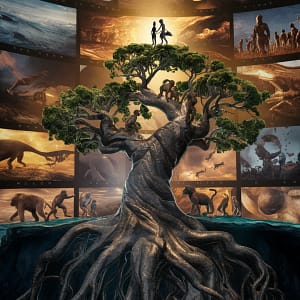
Theory of Evolution: The Story of Life's Transformation
The theory of evolution is a scientific explanation that suggests living species change gradually over time, descend from a common ancestor, and this change occurs through mechanisms such as natural selection, mutation, and genetic drift. This theory is one of the cornerstones of biological science and allows us to understand the diversity, complexity, and adaptability of life.
Basic Principles:
- Common Ancestor: It is thought that all living beings evolved from a common ancestor that lived billions of years ago. This explains the genetic, anatomical, and physiological similarities between living beings.
- Variability: Canlı popülasyonları içindeki bireyler, genetik varyasyonlar gösterir. Bu varyasyonlar, mutasyonlar (DNA’daki rastgele değişiklikler) ve genetik rekombinasyon (eşeyli üreme sırasında genlerin karışması) sonucu ortaya çıkar.
- Natural Selection: Environmental conditions affect the survival and reproduction chances of living beings. Individuals with advantageous traits tend to leave more offspring. This causes advantageous traits to become widespread in the population, while disadvantageous traits decrease.
- Adaptation: Living beings adapt to their environment through the process of natural selection. This adaptation means that living beings develop traits that increase their chances of survival and reproduction.
- Speciation: Over time, genetic differences between populations can accumulate, and these differences can lead to the formation of new species.
Evidence of Evolution:
- Fossil Records: Fossils, the remains of living beings from millions of years ago, show how species have changed over time. Fossils allow us to document changes in the anatomical structures of living beings and the emergence of new species.
- Biogeography: The distribution of living beings in different geographical regions supports the theory of evolution. For example, the similarities between bird species on nearby islands show that these species evolved from a common ancestor.
- Comparative Anatomy: Similar organs and structures in different living species (e.g., the human arm, bird wing, whale fin) indicate that these species descended from a common ancestor. Such similarities are called "homologous organs".
- Moleküler Biyoloji: DNA ve proteinlerdeki benzerlikler, canlılar arasındaki evrimsel ilişkileri ortaya koyar. İnsan ve şempanze DNA’sının %98 oranında benzer olması, bu iki türün yakın bir zamanda ortak bir atadan ayrıldığını gösterir.
- Embryology: Similarities between the embryos of different living species reflect evolutionary relationships. For example, the presence of gill slits and a tail in human embryos indicates that humans evolved from fish-like ancestors.
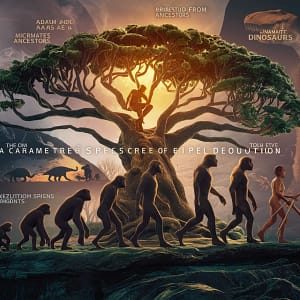
Acceptance in the Scientific Community:
The theory of evolution is overwhelmingly accepted by the scientific community. Numerous scientific studies and evidence support the theory of evolution. This theory has important applications not only in the field of biology but also in many different fields such as medicine, agriculture, and environmental science.
The theory of evolution is constantly being tested and developed through scientific methods. New findings and technologies allow us to better understand the process of evolution. However, the basic principles of the theory of evolution and the fact that living beings evolved from a common ancestor are indisputably accepted by the scientific community.
The Story of Adam and Eve: Beliefs and Interpretations
Adem ve Havva kıssası, semavi dinlerde insanlığın kökenine dair anlatılan merkezi bir hikayedir. Kuran-ı Kerim’de Bakara Suresi 22. ayet ve Araf Suresi 189. ayette yer alan ifadeler, Adem’in topraktan yaratıldığını ve Havva’nın da Adem’den yaratıldığını belirtir. Bu kıssa, insanın yaratılışı, ilk günah, cennetten kovuluş, tövbe ve af gibi kavramların temelinde yer alır.
Adam and Eve in the Quran:
- Creation: It is stated that Adam was created from clay and Eve from Adam.
- Paradise and the Forbidden Fruit: Adam and Eve sin by eating the forbidden fruit while living in paradise.
- Punishment and Repentance: They are expelled from paradise because of their sins but repent and are forgiven by God.
- Ancestors of Humanity: Adam and Eve are considered the ancestors of all people on Earth.
Different Religious Interpretations:
The story of Adam and Eve is a text open to different religious interpretations. These interpretations focus on the symbolic or literal meanings of the story.
- Literal Interpretation: Some interpreters accept the story as a real historical event and believe that the narratives happened exactly as described. According to this interpretation, Adam and Eve are the biological ancestors of all humanity.
- Symbolic Interpretation: Some other interpreters approach the story symbolically. According to this interpretation, Adam and Eve are archetypal figures representing the common experiences of humanity. The forbidden fruit symbolizes human free will and the desire to attain knowledge, while the expulsion from paradise represents the transition to earthly life and facing challenges.
- Sufi Interpretation: In the Sufi tradition, the story of Adam and Eve is interpreted as an allegory of the human journey to discipline the ego and get closer to God. Adam represents the pure and divine essence of man, while Eve represents the ego.
Other Creation Narratives:
Besides the story of Adam and Eve, different cultures and mythologies have various narratives about the creation of humans. For example, in Greek mythology, Prometheus shapes humans from clay, while in Chinese mythology, Nüwa makes humans from mud. These narratives offer different perspectives on the origin of humans and reflect a universal curiosity.
The story of Adam and Eve raises important questions about the origin and purpose of human existence. Different religious interpretations of this story hold different meanings for believers. However, regardless of which interpretation of the story is adopted, this narrative about the creation of man remains a thought-provoking story that maintains its place in human history.
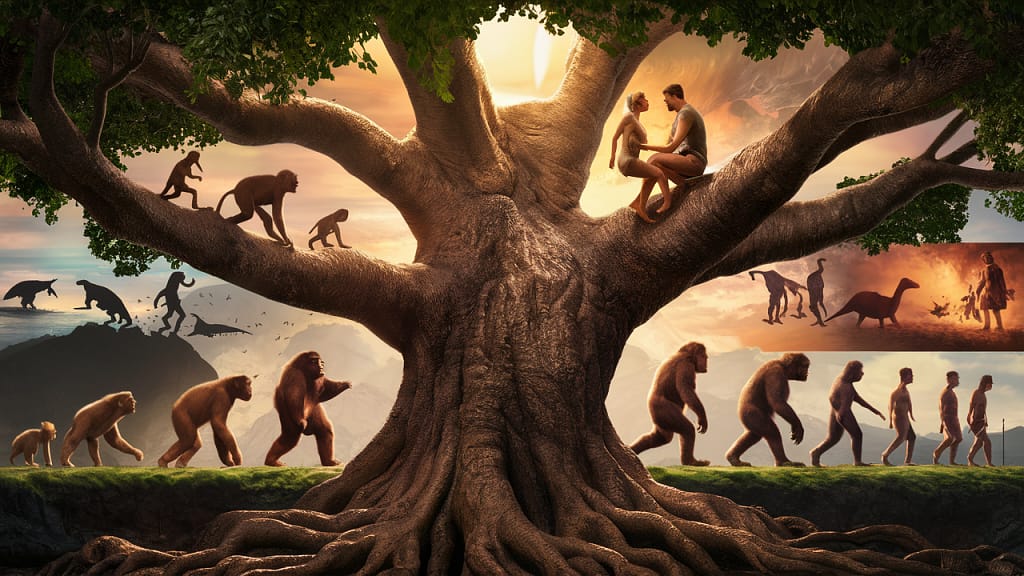
Science and Religion: Different Perspectives and Approaches
Science and religion are two of the most fundamental areas of knowledge and meaning-seeking in human history. Science seeks to understand the natural world through observation, experimentation, and reasoning, while religion focuses on issues of faith, values, morality, and spirituality. How these two fields interact has been interpreted in different ways throughout history, and various approaches have emerged.
Conflict Approach:
The conflict approach views science and religion as fundamentally opposed and irreconcilable. According to this view, the accuracy of scientific explanations is supported by evidence, while religious beliefs are dogmatic and unchanging. Therefore, scientific findings may contradict some statements in religious texts. For example, while the theory of evolution argues that living beings come from a common ancestor and change over time through natural selection, some religious texts state that humans were created directly. This situation, according to the conflict view, creates a conflict between science and religion.
Harmony Approach:
Uyumcu yaklaşım ise, bilim ve dinin farklı sorulara cevap verdiğini ve bu nedenle birbirleriyle çelişmek zorunda olmadığını savunur. Bilim, “nasıl?” sorusuna odaklanırken, din ise “neden?” ve “ne için?” sorularına cevap arar. Bu görüşe göre, bilimsel açıklamalar doğal dünyanın işleyişini anlamamızı sağlarken, dinî inançlar ise hayatımıza anlam ve amaç katar. Örneğin, evrim teorisi canlıların nasıl çeşitlendiğini ve uyum sağladığını açıklarken, dinî inançlar ise bu sürecin arkasında bir ilahi iradenin olup olmadığına dair sorularla ilgilenir.
Within the harmony approach, there are also different interpretations. Some thinkers argue that some expressions in religious texts have metaphorical meanings and do not contradict scientific facts. For example, interpreting the story of Adam and Eve symbolically or thinking that the process of evolution is guided by God.
Independence Approach:
The independence approach views science and religion as two completely separate and independent domains. According to this view, there is no need for conflict between science and religion since they answer different questions. Science uses observation and experiment-based methods to understand the natural world, while religion is concerned with faith, values, and spirituality. Therefore, scientific explanations are not expected to influence religious beliefs, nor are religious beliefs expected to guide scientific research.
When evaluating the relationship between the story of Adam and Eve and the theory of evolution, it is important to consider these different approaches. Each approach has its own consistent arguments and supporting evidence. However, it is not possible to explain the relationship between science and religion with a single approach. This relationship can be interpreted in different ways depending on historical, cultural, and personal factors.
In conclusion, the relationship between science and religion is a complex and multifaceted issue. How these two fields interact can vary depending on people's worldviews, beliefs, and values. However, understanding different approaches and perspectives is important for maintaining a healthy dialogue between science and religion.
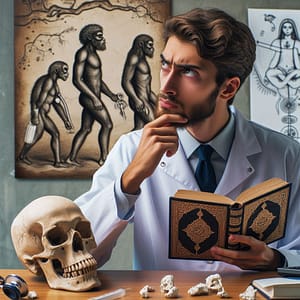
Claims of Contradiction: Areas of Tension Between the Theory of Evolution and the Story of Adam and Eve
Claims of incompatibility between the theory of evolution and the story of Adam and Eve often stem from approaches that adhere strictly to the literal interpretation of religious texts and disregard scientific findings. The fundamental areas of tension underlying these claims are shaped around the concepts of human origins, the process of creation, and the first human couple. However, each of these areas of tension can be addressed with different perspectives and interpretations, and potential solutions can be offered.
Human Origins
Evrim teorisi, insanın primat atalardan milyonlarca yıllık bir süreçte, doğal seçilim ve genetik değişimler yoluyla evrimleştiğini savunur. Bu, insanın diğer canlılarla ortak bir biyolojik geçmişe sahip olduğu anlamına gelir. Buna karşılık, dinî metinler insanın topraktan yaratıldığını belirtir. Bu noktada literal yorumcular, toprağın gerçek anlamda insanın hammaddesi olduğunu savunarak evrim teorisini reddederler. Ancak sembolik yorumcular, toprağın insanın dünyevi doğasını ve maddi kökenini temsil ettiğini öne sürerek evrimle uyumlu bir bakış açısı sunarlar. Bu yorum, insanın biyolojik olarak topraktan oluştuğu gerçeğini vurgularken, evrimsel süreçle çelişmez. Ayrıca teistik evrim yaklaşımı, evrim sürecini kabul etmekle birlikte, bu sürecin Tanrı’nın iradesi ve kontrolü altında gerçekleştiğini savunarak iki anlatıyı birleştirmeye çalışır. Bu yaklaşım, bilimsel bulguları inanca dahil ederek uyumlu bir sentez oluşturmayı hedefler.
The Process of Creation
Evrim teorisinin kademeli ve uzun süreli değişim süreciyle dinî metinlerdeki ani ve doğrudan yaratılış anlatısı arasındaki farklılık da bir gerilim alanı olarak görülür. Literal yorumcular, yaratılışın altı günde tamamlandığı ifadesini gerçek zaman dilimleri olarak kabul ederken, sembolik yorumcular bu günleri evrenin ve yaşamın oluşumundaki farklı aşamaları temsil eden mecazi bir anlatım olarak değerlendirirler. Bu yorum, yaratılışın uzun bir süreçte gerçekleştiği ve evrim teorisinin bulgularıyla çelişmediği şeklinde bir anlayışa olanak tanır. Ayrıca bazı ilahiyatçılar, “gün” kelimesinin İbranice karşılığı olan “yom” kelimesinin belirsiz bir zaman dilimini ifade edebileceğini ve bu nedenle yaratılışın uzun bir süreçte gerçekleştiği şeklinde yorumlanabileceğini belirtirler. Bu yorum, dinî metinlerin bilimsel bulgularla uyumlu bir şekilde okunabileceğini gösterir.
The First Human Couple
Adem ve Havva’nın insanlığın ilk çifti olduğu inancı, evrim teorisinin insanın belirli bir popülasyondan evrimleştiği ve tek bir ilk çiftin olmadığı iddiasıyla çelişir. Literal yorumcular, Adem ve Havva’nın tüm insanların biyolojik ataları olduğu görüşünü savunurken, sembolik yorumcular bu figürleri insanlığın ortak deneyimlerini ve ahlaki gelişimini temsil eden arketipler olarak görürler. Bu yorum, Adem ve Havva’nın gerçek kişiler olmasından ziyade, insan doğasının evrensel özelliklerini temsil eden sembolik figürler olarak anlaşılmasını sağlar. Teistik evrim yaklaşımında ise, Adem ve Havva’nın evrim sürecinde belirli bir aşamada seçilmiş ve Tanrı tarafından özel bir ruh veya bilinçle donatılmış olabileceği düşünülür. Bu yorum, insanın biyolojik evrimini kabul ederken, aynı zamanda insanın manevi boyutunu da vurgular.
In addition to these areas of tension, the differences between the emphasis on randomness and purposelessness of evolutionary theory and the understanding of divine will and purpose of religious beliefs are also a matter of debate. However, these differences can be interpreted as evolution explaining natural processes, while religion leads to thinking about the meaning and purpose of these processes. Thus, an understanding that science and religion answer different questions and do not exclude each other can be adopted.
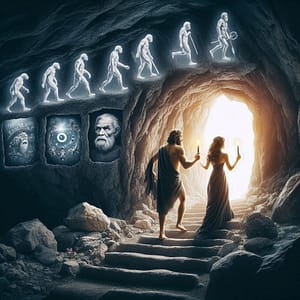
Alternative Interpretations: Bridges Between Evolution and the Story of Adam and Eve
When evaluating the relationship between the theory of evolution and the story of Adam and Eve, there are alternative approaches that offer different interpretations and points of reconciliation. These approaches aim to bridge the gap between two different perspectives by making scientific findings compatible with religious beliefs.
Theistic Evolution (Evolutionary Creation)
This approach accepts the theory of evolution, while arguing that the evolutionary process is guided and controlled by God. According to this interpretation, Adam and Eve may have been chosen by God at a certain stage in the evolutionary process and endowed with a special spirit or consciousness. This offers a perspective that explains both the biological and spiritual dimensions of man. Theistic evolution aims to provide a scientifically and religiously satisfying explanation by incorporating scientific findings into faith.
Symbolic Interpretation
This approach interprets the story of Adam and Eve not as a real historical event, but as a symbolic narrative representing the common experiences and moral development of humanity. According to this interpretation, Adam and Eve are archetypal figures representing man's free will, desire to attain knowledge, potential to sin, and ability to repent. This interpretation reveals the universal messages of the story and deep insights into human nature.
Spiritual Evolution
Bu yaklaşım, insanın sadece biyolojik olarak değil, aynı zamanda ruhani olarak da evrimleştiğini savunur. Bu yoruma göre, Adem ve Havva, insanlığın ruhani gelişiminde bir dönüm noktasını temsil eder. Onların hikayesi, insanın Tanrı’ya olan bağlılığını, ahlaki değerlerini ve manevi bilincini geliştirme sürecini anlatır. Bu yaklaşım, hem bilimsel hem de dinî öğretileri kapsayan bütüncül bir perspektif sunar.
The Interpretation of Adam and Eve as Symbolic Ancestors
Bu yaklaşım, Adem ve Havva’yı tüm insanlığın biyolojik ataları olarak değil, belirli bir topluluğun veya insanlık tarihinde yeni bir dönemin başlangıcını temsil eden sembolik figürler olarak yorumlar. Bu yoruma göre, Adem ve Havva’nın hikayesi, insanın sosyal, kültürel ve ahlaki gelişimindeki önemli bir aşamayı simgeler.
Divine Intervention in the Evolutionary Process
Bu yaklaşım, evrim teorisini kabul ederken, Tanrı’nın evrim sürecine belirli noktalarda müdahale ettiğini savunur. Örneğin, insanın bilinç kazanması veya ahlaki değerler geliştirmesi gibi kritik aşamalarda Tanrı’nın özel bir rol oynadığı düşünülebilir. Bu yorum, bilimsel açıklamalarla dinî inançları birleştirerek, evrim sürecine daha geniş bir anlam katmayı amaçlar.
These alternative interpretations offer different ways of trying to reconcile the theory of evolution with the story of Adam and Eve. Each interpretation has its own strengths and weaknesses. However, the common point of these interpretations is that they try to make scientific findings compatible with religious beliefs, rather than ignoring them. In this way, it may be possible to develop an understanding that is satisfying both scientifically and religiously.
Conclusion: The Meeting Point of Science and Faith: A Call for Dialogue
In this article, where we examined the relationship between the story of Adam and Eve and the theory of evolution in depth, we revealed the richness and complexity of different perspectives. We have seen that these two different narratives about the origin of humanity, although seemingly contradictory at first glance, can actually coexist without excluding each other.
In the light of scientific data, we know that the theory of evolution strongly supports that living things come from a common ancestor and change gradually over a period of millions of years. This theory shows that man is also a part of this evolutionary process and shares a common biological history with other living things. However, this does not mean that we ignore the spiritual dimension of man, his moral values and his search for meaning.
The story of Adam and Eve, beyond being a religious narrative about the creation of man, is a rich source that symbolizes the universal characteristics of human nature, free will, the desire to attain knowledge, the potential to sin, and the ability to repent. This story is an important source that people turn to when seeking answers to existential questions.
When evaluating the relationship between these two narratives, it is important to adopt an approach based on dialogue and understanding rather than a dogmatic approach. Instead of denying scientific findings or ignoring religious beliefs, trying to harmonize these two different sources of information can enable us to reach a more comprehensive and rich understanding.
Teistik evrim gibi yaklaşımlar, evrim teorisini kabul ederken aynı zamanda Tanrı’nın yaratıcı gücüne ve evrensel düzene olan inancı koruyarak, bilim ve din arasında bir köprü kurmaya çalışır. Bu yaklaşım, hem bilimsel gerçeklerle uyumlu hem de dinî inançları besleyen bir perspektif sunar.
Symbolic interpretations, on the other hand, consider the story of Adam and Eve as an allegory representing the common experiences and moral development of humanity. By focusing on the universal messages of the story, this interpretation can enable people from different beliefs and cultures to find common ground.
In conclusion, the relationship between the story of Adam and Eve and the theory of evolution is a constantly debated and reinterpreted issue with no single right answer. However, this debate itself is a reflection of man's search for meaning and his effort to attain knowledge. Therefore, it would be a more constructive approach to consider this debate as an opportunity to understand and respect different perspectives rather than as an area of conflict.
This article aims to encourage readers to think more about this issue and develop their own interpretations by addressing the relationship between the story of Adam and Eve and the theory of evolution from different angles. Let's not forget that science and religion are important tools in man's search for meaning, and using these two tools together can enable us to reach a richer and deeper understanding.
References in the Article on Adam and Eve and Evolution:
Scientific Articles:
Nature
The world's leading multidisciplinary science journal. It has published many important articles on the theory of evolution.
Example article: “Initial sequence of the chimpanzee genome and comparison with the human genome” (2005) – Bu makale, insan ve şempanze genomlarının karşılaştırılmasıyla evrimsel ilişkilere dair önemli bilgiler sunar. Nature dergisindeki diğer evrim teorisi makalelerine buradan ulaşabilirsiniz: https://www.nature.com/subjects/evolutionary-biology
Science
One of the world's most prestigious scientific journals. It has published many groundbreaking articles on evolutionary theory and human evolution.
Example article: “A draft sequence of the Neanderthal genome” (2010) – Bu makale, insanın evrimsel geçmişine ışık tutan Neandertal genomunun dizilimini sunar.Science dergisindeki diğer evrim teorisi makalelerine buradan ulaşabilirsiniz: https://www.sciencedaily.com/releases/2010/05/100506141549.htm
Human Evolution and Genetic Studies
Example source: “Sapiens: A Brief History of Humankind” (Yuval Noah Harari) – Bu kitap, insanın evrimsel tarihini anlaşılır bir dille anlatır.
Other sources: Popular science magazines and websites such as National Geographic, Scientific American provide up-to-date information on human evolution and genetic studies.
Religious Texts
The Holy Quran
Bakara Suresi 22: “Sizi bir tek nefisten yaratan ve ondan da eşini yaratan, ikisinden birçok erkekler ve kadınlar üretip yayan O’dur. Allah’a karşı gelmekten sakının, O’na hesap vereceğinizden korkun. Yakınlarınızla iyi geçinin. Şüphesiz Allah, üzerinizde gözetleyicidir.”
Araf Suresi 189: “Sizi bir tek nefisten yaratan ve ondan da huzur bulsun diye eşini yaratan O’dur. O nefs ondan gebe kalınca hafif bir yük yüklendi. Onu bir müddet taşıdı. Yükü ağırlaşınca her ikisi de, “Eğer bize sağlıklı bir çocuk verirsen, elbette şükredenlerden olacağız” diye Rablerine dua ettiler.”
Torah (Genesis)
Genesis 1:27: "So God created mankind in his own image, in the image of God he created them; male and female he created them."
Works of Different Religious Commentators
Example: The Quran commentaries of exegetes such as Elmalılı Hamdi Yazır, Seyyid Kutub, Mevdudi, Ibn Kesir.
Philosophy and Philosophy of Religion Books
Ian Barbour, "When Science Meets Religion": An important work that addresses the relationship between science and religion with different approaches.
John Polkinghorne, "Science and Theology": A book that argues that science and religion are two different sources of knowledge that complement each other.
Alister McGrath, "Science & Religion: A New Introduction": A resource that summarizes current debates about the relationship between science and religion.
These sources will help you better understand the relationship between the story of Adam and Eve and the theory of evolution. To learn more about this topic, you can review these resources and evaluate different perspectives.